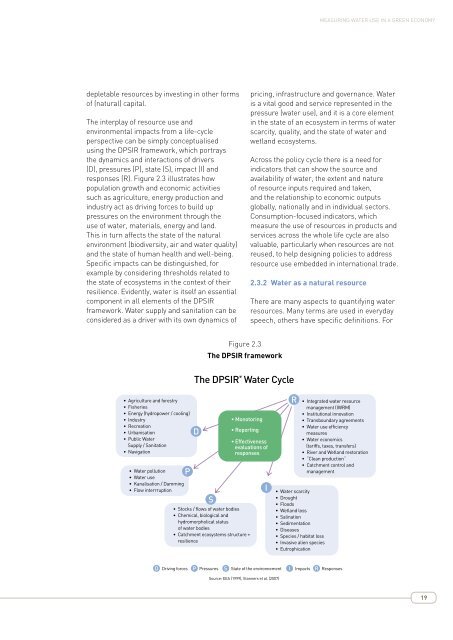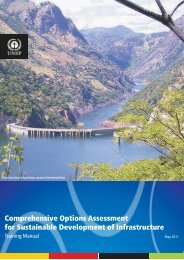MEASURING WATER USE IN A GREEN ECONOMY - UNEP
MEASURING WATER USE IN A GREEN ECONOMY - UNEP
MEASURING WATER USE IN A GREEN ECONOMY - UNEP
You also want an ePaper? Increase the reach of your titles
YUMPU automatically turns print PDFs into web optimized ePapers that Google loves.
Measuring water use in a green economy<br />
depletable resources by investing in other forms<br />
of (natural) capital.<br />
The interplay of resource use and<br />
environmental impacts from a life-cycle<br />
perspective can be simply conceptualised<br />
using the DPSIR framework, which portrays<br />
the dynamics and interactions of drivers<br />
(D), pressures (P), state (S), impact (I) and<br />
responses (R). Figure 2.3 illustrates how<br />
population growth and economic activities<br />
such as agriculture, energy production and<br />
industry act as driving forces to build up<br />
pressures on the environment through the<br />
use of water, materials, energy and land.<br />
This in turn affects the state of the natural<br />
environment (biodiversity, air and water quality)<br />
and the state of human health and well-being.<br />
Specific impacts can be distinguished, for<br />
example by considering thresholds related to<br />
the state of ecosystems in the context of their<br />
resilience. Evidently, water is itself an essential<br />
component in all elements of the DPSIR<br />
framework. Water supply and sanitation can be<br />
considered as a driver with its own dynamics of<br />
pricing, infrastructure and governance. Water<br />
is a vital good and service represented in the<br />
pressure (water use), and it is a core element<br />
in the state of an ecosystem in terms of water<br />
scarcity, quality, and the state of water and<br />
wetland ecosystems.<br />
Across the policy cycle there is a need for<br />
indicators that can show the source and<br />
availability of water, the extent and nature<br />
of resource inputs required and taken,<br />
and the relationship to economic outputs<br />
globally, nationally and in individual sectors.<br />
Consumption-focused indicators, which<br />
measure the use of resources in products and<br />
services across the whole life cycle are also<br />
valuable, particularly when resources are not<br />
reused, to help designing policies to address<br />
resource use embedded in international trade.<br />
2.3.2 Water as a natural resource<br />
There are many aspects to quantifying water<br />
resources. Many terms are used in everyday<br />
speech, others have specific definitions. For<br />
Figure 2.3<br />
The DPSIR framework<br />
The DPSIR * Water Cycle<br />
• Agriculture and forestry<br />
• Fisheries<br />
• Energy (hydropower / cooling)<br />
• Industry<br />
• Recreation<br />
• Urbanisation<br />
• Public Water<br />
Supply / Sanitation<br />
• Navigation<br />
• Water pollution<br />
• Water use<br />
• Kanalisation / Damming<br />
• Flow interrruption<br />
P<br />
D<br />
S<br />
• Monotoring<br />
• Reporting<br />
• Effectiveness<br />
evaluations of<br />
responses<br />
• Stocks / flows of water bodies<br />
• Chemical, biological and<br />
hydromorpholical status<br />
of water bodies<br />
• Catchment ecosystems structure +<br />
resilience<br />
I<br />
R<br />
• Water scarcity<br />
• Drought<br />
• Floods<br />
• Wetland loss<br />
• Salination<br />
• Sedimentation<br />
• Diseases<br />
• Species / habitat loss<br />
• Invasive alien species<br />
• Eutrophication<br />
• Integrated water resource<br />
management (IWRM)<br />
• Institutional innovation<br />
• Transboundary agreements<br />
• Water use efficiency<br />
measures<br />
• Water economics<br />
(tariffs, taxes, transfers)<br />
• River and Wetland restoration<br />
• “Clean production“<br />
• Catchment control and<br />
management<br />
D<br />
Driving forces P Pressures S State of the environnement I Impacts<br />
R<br />
Responses<br />
Source: EEA (1999), Stanners et al. (2007)<br />
19

















